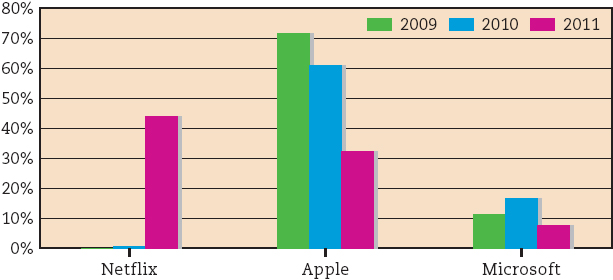Convergence: Movies Adjust to the Digital Turn
The biggest challenge the movie industry faces today is the Internet. As broadband Internet service connects more households, movie fans are increasingly getting movies from the Web. After witnessing the difficulties that illegal file-sharing brought on the music labels (some of which share the same corporate parent as film studios), the movie industry has more quickly embraced the Internet for movie distribution. Apple’s iTunes store began selling digital downloads of a limited selection of movies in 2006, and in 2008 iTunes began renting new movies from all of the major studios for just $3.99. In the same year, online DVD rental service Netflix began streaming some movies and television shows to customers’ computer screens and televisions.
The popularity of Netflix’s streaming service opened the door to other similar services. Hulu, a joint venture by NBC Universal (Universal Studios), News Corp. (Twentieth Century Fox), and Disney, was created as the studios’ attempt to divert attention from YouTube and get viewers to watch free, ad-supported streaming movies and television shows online or subscribe to Hulu Plus, Hulu’s premium service. Comcast operates a similar Web site, called Xfinity. Google’s YouTube, the most popular online video service, moved to offer commercial films in 2010 by redesigning its interface to be more film-friendly and offering online rentals. Amazon.com, Vudu (owned by Walmart), and CinemaNow (owned by retailer Best Buy) also operate digital movie stores.
Movies are also increasingly available to stream or download on mobile phones and tablets. Several companies, including Netflix, Hulu, Amazon, Google, Apple, Redbox and Blockbuster, have developed distribution to mobile devices. Small screens don’t offer an optimal viewing experience, but if customers watch movies on their mobile devices, they will likely use the same company’s service to continue viewing on the larger screens of computers and televisions.

Source: IHS Screen Digest June 2012.
The year 2012 marked a turning point: for the first time, movie fans accessed more movies through digital online media than physical copies, like DVD and Blu-ray.17 For the movie industry, this shift to Internet distribution has mixed consequences. On one hand, the industry needs to offer movies where people want to access them, and digital distribution is a growing market. “We’re agnostic about where the money comes from,” says Eammon Bowles, president of the independent distributor Magnolia Pictures. “We don’t care. Basically, our philosophy is we want to make the film available for however the customer wants to purchase it.”18 On the other hand, although streaming is less expensive than producing physical DVDs, the revenue is still much lower compared to DVD sales. Hollywood is responding by offering UltraViolet, a digital rights service that enables buyers of movies on DVD/Blu-ray to enter a code and stream or download those same movies from their cloud library to multiple devices.
The digital turn creates two long-term paths for Hollywood. One path is that studios and theaters will lean even more heavily toward making and showing big-budget blockbuster film franchises with a lot of special effects, since people will want to watch those on the big screen (especially IMAX and 3-D) for the full effect—and they are easy to export for international audiences. The other path features inexpensive digital distribution for lower-budget documentaries and independent films, which likely wouldn’t get wide theatrical distribution anyway but could find an audience in those who watch from home.
The Internet has also become an essential tool for movie marketing, and one that studios are finding less expensive than traditional methods like television ads or billboards. Films regularly have Web pages, but many studios also now use a full menu of social media to promote films in advance of their release. For example, Lionsgate’s 2012 movie The Hunger Games employed “near-constant use of Facebook and Twitter, a YouTube channel, a Tumblr blog, iPhone games and live Yahoo streaming from the premiere” to build interest that made it a hit film.19